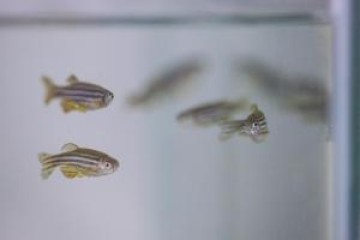Zebrafish behavioural assays to identify genetic mechanisms underlying drug seeking and addiction

At a glance
R
- Refinement
Contents
Application abstract
Human studies show that genetic factors contribute to an individual's vulnerability to drug dependence, but few genetic markers have been identified. Nonetheless, recent evidence suggests that tailoring treatment to individual characteristics based on the small number of available genetic markers improves treatment outcomes. Impulsivity and novelty seeking are risk factors for vulnerability to drug dependence; novelty seeking predicts propensity to initiate drug taking, impulsivity is associated with progression to compulsive drug taking and return to drug taking following abstinence (relapse). These latter aspects are key characteristics of drug addiction, with relapse presenting the greatest challenge for treatment. Increasing understanding of the genetic contributions to drug-seeking behaviour will aid the development of new therapies to improve treatment outcomes. Here we develop assays of impulsivity and novelty seeking in zebrafish and use these to selectively-breed lines to identify genetic mechanisms contributing to drug addiction. We have shown previously that zebrafish have a conserved reward response to drugs of abuse, and have developed assays of compulsive drug seeking and relapse in zebrafish. Here we use modifications of the novel object, open field assay and delayed reward tasks used in rodents to relate novelty seeking and impulsivity in zebrafish to drug seeking behaviour. Once assays predictive of drug seeking in zebrafish are developed we will use these to screen adults from families of ENU-mutagenised fish to establish lines that show altered drug seeking behaviour. ENU-mutagenesis introduces single nucleotide variations in the genome that may alter drug seeking behaviour and act as markers for genome association studies. The existence of ENU-mutagenised zebrafish lines is an enormous resource facilitating the identification of linked alleles in zebrafish not available in other vertebrate species. In order to obtain a similar resource in rodents expensive, ethically and technically challenging mutagenesis programmes would be required. As the neurochemical pathways involved in drug seeking are evolutionarily conserved and there is a high degree of sequence and functional homology between zebrafish and mammalian genes, results found in zebrafish have translational relevance. Use of zebrafish for neurobehavioural research represents a great opportunity for reduction of the use of higher order vertebrate species thereby reducing animal suffering. The development of zebrafish lines with heightened sensitivity to drugs of abuse and establishment of suitable assays has the potential to minimise costs, both material and ethical, in drug development programmes.
Impacts
- Blog: Five reasons why zebrafish make excellent research models
- Engagement Activities: Pint of Science 2014
Publications
- García-González J et al. (2021). Behavioral Effects of Developmental Exposure to JWH-018 in Wild-Type and Disrupted in Schizophrenia 1 (disc1) Mutant Zebrafish. Biomolecules 11(2): 319. doi: 10.3390/biom11020319
- Brock AJ et al. (2017). Assessing the Value of the Zebrafish Conditioned Place Preference Model for Predicting Human Abuse Potential. The Journal of Pharmacology and Experimental Therapeutics 363(1):66-79. doi: 10.1124/jpet.117.242628
- Baiamonte M et al. (2016). Sustained effects of developmental exposure to ethanol on zebrafish anxiety-like behaviour. PLoS ONE 11(2):e0148425. doi: 10.1371/journal.pone.0148425
- Martins VL et al. (2016). Suppression of TGFβ and Angiogenesis by Type VII Collagen in Cutaneous SCC. Journal of the National Cancer Institute 101(1). doi: 10.1093/jnci/djv293
- Parker MO et al. (2016). Moderate alcohol exposure during early brain development increases stimulus-response habits in adulthood. Addiction Biology 21(1):49-60. doi: 10.1111/adb.12176
- Stewart AM et al. (2015). Molecular psychiatry of zebrafish. Mol Psychiatry 20(1):2-17. doi: 10.1038/mp.2014.128
- Parker MO et al. (2015). Developmental role of acetylcholinesterase in impulse control in zebrafish. 9(271):1-11. doi: 10.3389/fnbeh.2015.00271
- Baiamonte M et al. (2015). Sustained action of developmental ethanol exposure on the cortisol response to stress in zebrafish larvae and adults. PLoS ONE 10(4):e0124488. doi: 10.1371/journal.pone.0124488
- Proulx MJ et al. (2014). Parallel mechanisms for visual search in zebrafish. PLoS ONE 9(10):e111540. doi: 10.1371/journal.pone.0111540
- Parker MO et al. (2014). Atomoxetine reduces anticipatory responding in a 5-choice serial reaction time task for adult zebrafish. Psychopharmacology 231(13):2671-9. doi: 10.1007/s00213-014-3439-z
- Parker MO et al. (2014). The utility of zebrafish to study the mechanisms by which ethanol affects social behavior and anxiety during early brain development. Progress in Neuro-Psychopharmacology and Biological Psychiatry 55:94-100. doi: 10.1016/j.pnpbp.2014.03.011
- Parker MO et al. (2013). Behavioural phenotyping of casper mutant and 1-pheny-2-thiourea treated adult zebrafish. Zebrafish 10(4):466-71. doi: 10.1089/zeb.2013.0878
- Parker MO et al. (2013). The role of zebrafish (Danio rerio) in dissecting the genetics and neural circuits of executive function. Frontiers in Neural Circuits 7:63. doi: 10.3389/fncir.2013.00063
- Parker MO et al. (2013). Development and automation of a test of impulse control in zebrafish. Frontiers in Systems Neuroscience 7:65. doi: 10.3389/fnsys.2013.00065
- Parker MO and Brennan CH (2012). Zebrafish (Danio rerio) models of substance abuse: Harnessing the capabilities. Behaviour 149(10-12):1037-1062. doi: 10.1163/1568539X-00003010
- Parker MO et al. (2012). Housing conditions differentially affect physiological and behavioural stress responses of zebrafish, as well as the response to anxiolytics. PLoS ONE 7(4):e34992. doi: 10.1371/journal.pone.0034992
- Parker MO et al. (2012). Development and implementation of a three-choice serial reaction time task for zebrafish (Danio rerio). Behavioural Brain Research 227(1):73-80. doi: 10.1016/j.bbr.2011.10.037
- Parker MO et al. (2012). Discrimination reversal and attentional sets in zebrafish (Danio rerio). Behavioural Brain Research 232(1):264-8. doi: 10.1016/j.bbr.2012.04.035
- Brennan CH (2011). Zebrafish behavioural assays of translational relevance for the study of psychiatric disease. Reviews in the Neurosciences 22(1):37-48. doi: 10.1515/RNS.2011.006
- Brennan CH et al. (2011). Conditioned Place Preference Models of Drug Dependence and Relapse to Drug Seeking: Studies with Nicotine and Ethanol. In: Kalueff A., Cachat J. (eds) Zebrafish Models in Neurobehavioral Research. Neuromethods, vol 52. Humana Press, Totowa, NJ doi: 10.1007/978-1-60761-922-2_7
